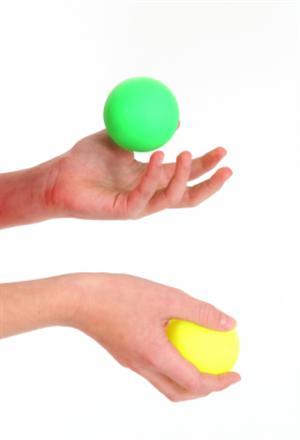| Complexity level: | 3 |
| Project cost ($): | 10 |
| Time required: | 1 hour to prepare, 1 hour for experiment |
| Material availability: | Easily found |
| Safety concerns: | None |
Hypothesis
Older children will have better hand-eye coordination then younger children.
Overview
Why is hand-eye coordination important?
Hand-eye coordination is important as it helps us in most of our daily activities, from making coffee towriting, driving, sports activities and even playing computer games. The information seen by the eye is sent to the brain which will then process this information and send signals through our nerves to the muscles in our hand, to respond accordingly.
Therefore hand-eye coordination is very important. Without it we will not be able to avert danger, build homes, harvest food and acquire other skills.
Hand eye coordination in children
Hand-eye coordination starts to develop in children from infancy through their middle childhood.
- 3 months - the connection between the hand and eye is made and the child recognizes his/her hand
- 6 months - the child starts to reach out and play with toys
- 18 months - starts to learn simple tasks like using a fork and spoon to feed him/herself
- 4 years - the child learns simple skills like writing and buttoning shirts
- 9 years - the child hand-eye coordination is fully developed. From here onwards, it is the individual ability and aptitude of the child that will affect the child's development
Scientific Terms
Materials
The materials required for this experiment:
- 5 boys and 5 girls aged 10
- 5 boys and 5 girls aged 15
- 1 ping pong ball
- A stop watch
- A flat floor surface
- An assistant to time the experiment.
Procedure
- For this experiment, the independent variable is the age and gender of the participant. The dependent variable is the number of times the ping pong ball is caught in one minute. This is determined by counting and using a stop watch to measure the time. The constants (control variables) are the surface of the floor, the time given to catch the ball and the type of ball used.
- The 1st participant is given the ping pong ball to hold in his/her right hand.
- The assistant starts the stop watch and instructs the participant to begin.
- The participant is to dribble the ball between both hands. Holding the ping pong ball in the right hand, drop the ping pong ball on the floor. When the ball bounces up, it is caught using the left hand. Repeat using the other hand.
- Count the number of time the participant drops and catches the ping pong ball.
- At the end of 1 minute, the assistant instructs the participant to stop. The number of times the ping pong ball is bounced is recorded in the table below.
- Repeat steps 2 to 6 for the remaining 19 boys and girls.
Results
| Grouping | Number of times the ping pong ball was dropped and caught | Average | ||||
| 1 | 2 | 3 | 4 | 5 | ||
| Boys age 10 | 34 | 41 | 39 | 32 | 44 | 38 |
| Boys age 15 | 52 | 56 | 55 | 59 | 58 | 56 |
| Girls age 10 | 36 | 29 | 38 | 33 | 34 | 34 |
| Girls age 15 | 57 | 47 | 59 | 55 | 52 | 54 |
The results show that the 15 year old children have better hand-eye coordination then the 10 year old children. This is because the 15 year olds were able to catch the ping pong ball an average of 54-56 times compared to the 10 year olds who managed to catch the ball only 34-38 times. There was no significant difference in the results for the boys and girls of the same age.
Conclusion
The hypothesis that older children will have better hand-eye coordination skills then the younger children is proven to be true. Children will normally improve in their hand eye coordination skills as they grow older.
Hand-eye coordination is very important for our survival in this world. Without it, we will not be able to perform our most basic daily chores. Most of one's childhood is spent developing hand-eye coordination skills that will help us become more independent as we grow older.
Also consider
The experiment can be repeated by bouncing the basket ball off a wall and catching it. See if using the bigger basket ball produces the same results.
Try to change the experiment to count the number of times the children fail to catch the ball. You might also consider having the children play a simple computer game that involves movement or control of a joystick/gamepad.
References
- Hand-eye coordination, Encyclopedia of Psychology, Apr 06, 2001

